|
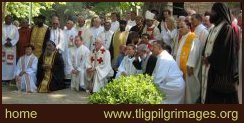 |
read also a report by Fr. John Twistleton
A PERSONAL REFLECTION FROM THE TRUE LIFE IN GOD ECUMENICAL PILGRIMAGE 2007
BY FR. GAVIN ASHENDEN
(Senior Chaplain and Lecturer in the Psychology of Religion at the University of Sussex, Examining Chaplain to the Bishop of Chichester, Diocesan Advisor on New Age Religions, Member of the General Synod of the Church of England.)
PLACES
Perhaps this is the most immediately accessible aspect of a pilgrimage. One visits places that were important in the history and experience of the Church and the wider pilgrimage through time and space. Everyone's reflections on these will be different, but for each of us one or two of these places will have a special impact. It was captivating to see the tombs in Cappadocia, where Christians hid in times of trouble. The landscape was like nothing I have ever seen before.
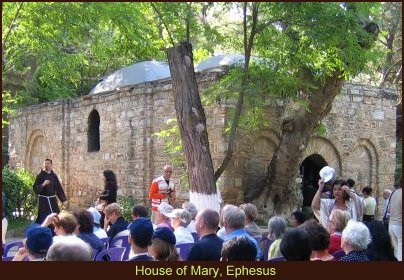 But what struck me most was the house of Mary in Ephesus. A number of people talked about the effect of this place. I did not know what I was looking for, although one of the ways in which the True Life in God messages have changed me is to open my eyes to the importance of Mary, our Lord's Mother. To go on pilgrimage is to know that one's views are going to evolve, be clarified and sometimes completely change. I had always known, as an Anglican, that She was important theologically. I had always treasured Her title of Theotokos. But it was other priests and people, rather than me, who talked about their closeness to Her. I was a little bemused by this, and thought that perhaps it was just part of the psychological profile; a way of interacting with the feminine perhaps.
But what struck me most was the house of Mary in Ephesus. A number of people talked about the effect of this place. I did not know what I was looking for, although one of the ways in which the True Life in God messages have changed me is to open my eyes to the importance of Mary, our Lord's Mother. To go on pilgrimage is to know that one's views are going to evolve, be clarified and sometimes completely change. I had always known, as an Anglican, that She was important theologically. I had always treasured Her title of Theotokos. But it was other priests and people, rather than me, who talked about their closeness to Her. I was a little bemused by this, and thought that perhaps it was just part of the psychological profile; a way of interacting with the feminine perhaps.
Then I found in the messages how vivid, alive, important and involved St Mary was. And I realised that it should no longer be a matter of personal preference, but should become something much stronger in my prayers and my relationship with the Lord. Her house and the place it was set added strongly to this developing awareness. There was a particular strength of colour in the place. The air was a little more luminescent, it seemed to me. The grass had a lusciousness that was out of the ordinary. It was fertile and rich and deep and vibrant. The Eucharist was particularly joyful. This was not a matter of group dynamics; it was entering into a deeper place in God, in a way that is simply given. That place gave it; which of course means our Lady gave it. The place does not provide exclusive closeness to our Lord and His Mother, but it shows to what depths we are being called. And perhaps by our prayers and attention, we ourselves can allow Her and our Lord to make the places we are set in, wider and more luxuriant gateways into the Kingdom.
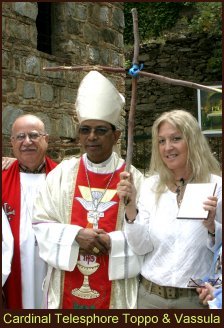 Ever since I knew we were coming to Izmir, Ephesus, I have been hearing in my mind an echo of the chant 'Great is Diana of the Ephesians'. It's clear from Scripture and history that Ephesus was a magnificent place, understandably full of its own importance. Walking down the main street, my admiration for St Paul grew immeasurably. To arrive here with the Gospel and take on all this power, wealth and vested interest, and to become so threatening to them as Acts describes, as well bringing people to an experience of the risen Christ.... what courage and what holiness.
Ever since I knew we were coming to Izmir, Ephesus, I have been hearing in my mind an echo of the chant 'Great is Diana of the Ephesians'. It's clear from Scripture and history that Ephesus was a magnificent place, understandably full of its own importance. Walking down the main street, my admiration for St Paul grew immeasurably. To arrive here with the Gospel and take on all this power, wealth and vested interest, and to become so threatening to them as Acts describes, as well bringing people to an experience of the risen Christ.... what courage and what holiness.
Patmos was the most moving of all for me. It may have been my imagination, but I felt as though there was a grey veil over Turkey, and it began to lift as we moved towards the Greek islands. It felt like metaphysics rather than atmospherics, but whatever it was, it was real and much more than the weather.
Shortly after being converted as a young law student I had met an Anglican priest who told me of how deep an experience of renewal he had experienced when he had gone to Patmos and sat in St. John's cave and read the Apocalypse in Greek. One day, I thought, I want to do that. The day had finally come, 30 years later.
And so another change the pilgrimage effected; relationship with the last book in the Bible. In academic theological circles, it has long been assumed that the Apocalypse was not written by the same person who wrote the fourth Gospel; and if John the beloved disciple wrote the fourth Gospel, then another John wrote the apocalyptic. But my experience on Patmos has started to inform my outlook again on the dynamics of the kingdom of heaven.
The argument goes that the style of writing, of grammar, vocabulary, the grasp of Greek itself, is very different between the two texts. I learnt now of St John's secretary, known in tradition even if not trusted in academia. The possibility that some of the responsibility for this belongs to John's amanuensis, who did the writing, restored the book to me as a source of revelation and inspiration. It has been put back on my theological map. More important even than that, was my discovery that in certain parts of the TLIG messages our Lord quotes widely from the Apocalypse. My theological mind has been changed. If Jesus is right, I must be wrong. And I find myself becoming attuned through the Messages to a new taste for metaphor and hyperbole that I already recognised as an accent of our Lord's in the Gospel, but which is particularly vivid in the TLIG messages.
And my imagined view of the cave had been all wrong! I had seen it as a traditional cave on a sea shore. Instead it was more like a womb in the hillside.
PRAYER
I found something of a shift taking place in my experience of the concelebrated Eucharist. The first experience had been astonishment that such a thing could happen in front of my eyes. To see a Cardinal Archbishop reverently sharing in the Eucharist presided over by the Anglican Bishop of Jerusalem was more moving than I can find words for; a healing of so much misunderstanding and antagonism.
On the last pilgrimage of 2005, I saw these celebrations as a futuristic prophetic witness of what God wanted, but might only make available in the Church at some long distant time in the future. This time I saw them as utterly normal. It was what we did more regularly in our denominational fragmentation that was the aberration; this togethernerness around the altar was the Church. This was normal. This was more real. At last, like a Christmas day when a family that had been scattered to the four corners of the earth and out of touch with each other too long, came home to sit around one table and celebrate. We are not the Church without each other.
Inevitably the TLIG pilgrimage raises the question of how right it is to suspend the theological questions that constitute the road towards sacramental unity. In the Messages we find that the Lord reverses our preoccupation with the theology. When the Eucharist was celebrated each day with the different faces of the Church, Catholic, Orthodox and Anglican, all infused by the Holy Spirit, the answer became so clear: around the altar first. Instead of the Eucharist and our sacramental theology and Church politics being the determining issues, here instead was a healed Church; our Lord's Body restored: the glory of the separate strands woven together as He became present amongst us in the bread and the wine, and in the devotion, adoration and love. These daily Eucharists turned a theological viewpoint into the foretaste of the Kingdom of heaven.
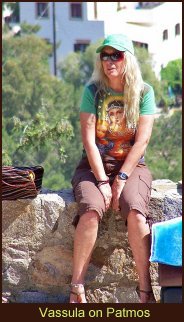 Each celebration had its own flavour of delight. But the two for me that held the most intensity were at St. Mary's house in Ephesus where the air and ground was charged with a sweetness that flowed into our prayers, and at Pentecost on Patmos where standing above the cave in which St John was given a glimpse of the future of time and space, drawn together in our Lord's purposes, we too were given a glimpse of the Church drawn prophetically together in the Lord's purposes, become one in the Eucharist, drawn together by the centripetal energy of love.
Each celebration had its own flavour of delight. But the two for me that held the most intensity were at St. Mary's house in Ephesus where the air and ground was charged with a sweetness that flowed into our prayers, and at Pentecost on Patmos where standing above the cave in which St John was given a glimpse of the future of time and space, drawn together in our Lord's purposes, we too were given a glimpse of the Church drawn prophetically together in the Lord's purposes, become one in the Eucharist, drawn together by the centripetal energy of love.
But there is a cost in this. Now at home, when the Eucharist is offered, I look round and say, where is the rest of the Church?
PURGATION
Something happens when one reads the Messages. I have become aware of some internal work taking place. Perhaps it is because they are a conversation with the Lord, and in any conversation the heart is opened up in dialogue. And if opened in dialogue, one is never exactly the same person after the conversation that one was before: however infinitesimally small, a change has taken place.
During the pilgrimage this process seemed to be sped up. My mind, which earns its living as an academic as well as a priest was brought captive to the adoring heart in a way that reverses the normal pattern of life for me. For some time now, I have been pondering on how the mind and the heart should relate to each other in discipleship. My clue should have been found in the Orthodox aphorism that one is to come before the Real God with the real Self, with the mind in the heart.
I found during this pilgrimage that many of my normal views were changing fast. The heart had priority. The mind has a job to do, and I love it. But the priority was the heart, and the mind was invited to stand in the heart, enclosed by the heart. In worship, the mind steadily quietens as the heart becomes the dominant partner. Something in the pilgrimage evoked the heart in a particularly stirring way. It may have been being in the company of the whole Church - it may have been so much prayer preceding it - it may have the potency of the united Church in love and worship in such a unique way; but it had the effect of speeding up the inner cleansing that the presence of God brings.
PEOPLE
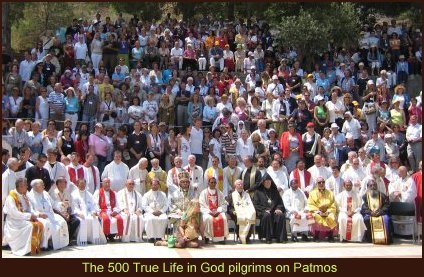 One of the most exhilarating aspects of a pilgrimage is the expectation of the people the Lord will send us to and send to us. Each of the two TLIG pilgrimages have etched people in my memory quite as much as places. So, casual words at a meal can become incisive words, sculpted by the Holy Spirit, that speak to a situation that one hardly knew even required addressing. The pilgrimage almost takes the form of a drawn out confession in which things get shared, absolved, and processed into the dynamics of the Kingdom of heaven. There was such a lot of wisdom. And even in less charged conversations there was a flow of love and intimacy and kindness that decorated the days. Without recounting the conversations themselves it is not easy to give a flavour of how the days seemed to have this benign intensity of encounter. Perhaps most of all, there was this comfort that one's longing to love the Lord, to encounter Him and to stay close to Him, was more normal that the routine of every day life away from these companions.
One of the most exhilarating aspects of a pilgrimage is the expectation of the people the Lord will send us to and send to us. Each of the two TLIG pilgrimages have etched people in my memory quite as much as places. So, casual words at a meal can become incisive words, sculpted by the Holy Spirit, that speak to a situation that one hardly knew even required addressing. The pilgrimage almost takes the form of a drawn out confession in which things get shared, absolved, and processed into the dynamics of the Kingdom of heaven. There was such a lot of wisdom. And even in less charged conversations there was a flow of love and intimacy and kindness that decorated the days. Without recounting the conversations themselves it is not easy to give a flavour of how the days seemed to have this benign intensity of encounter. Perhaps most of all, there was this comfort that one's longing to love the Lord, to encounter Him and to stay close to Him, was more normal that the routine of every day life away from these companions.
Throughout my Christian life I have been so delighted when the presence of Christ leaps out of the eyes of someone who carries him in their heart. In this pilgrimage, one of the strongest memories will be one or two fellow priests, particularly those whose English was poor or non-existent, but with whom I felt a profound bond of love, and a very deep respect as I saw how much of Jesus they carried in their eyes, and minds and hearts. This was the unity of the Church, the charism of Christ. This was my food for the journey of this True Life in God pilgrimage as well as the other one that is the gift of my life.
Fr Gavin Ashenden